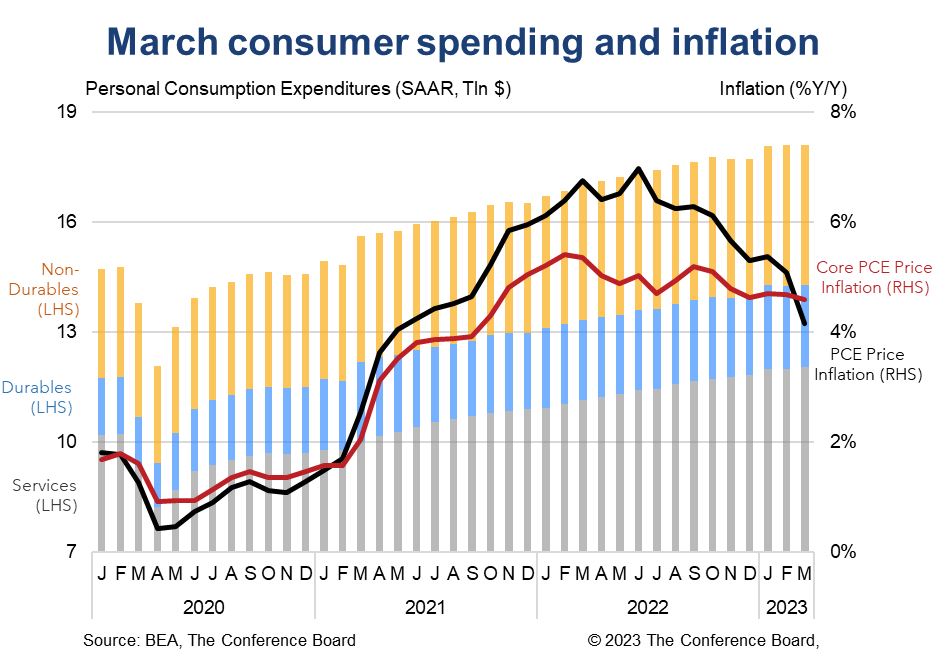-
Email
Linkedin
Facebook
Twitter
Copy Link

Loading...
Personal income, spending and inflation all saw small improvements in March. Personal income growth expanded modestly for the month and real spending was flat (it contracted in February). Meanwhile, inflation metrics for March cooled. Headline PCE price inflation fell to 4.2 percent from a year earlier and dropped to 0.1 percent in month-over-month terms. Core PCE price inflation also saw softer numbers for the month. Collectively, this report showed that the US consumer is holding up and that inflation is moderating. Given yesterday’s GDP print we had expected a more troubling report this morning, but revisions to January and February data resulted in more favorable readings for March than anticipated. The Federal Reserve will likely welcome these data, but may be disappointed that more progress on inflation is not being made more quickly. We continue to forecast that the Fed will raise interest rates by 25 basis points twice more – once next week and once in June. Thereafter, we expect interest rates to stay flat for the remainder of 2023. Headline PCE price inflation fell from 5.1 to 4.2 percent year-over-year (y/y) in March and core PCE price inflation (which excludes food and energy) fell from 4.7 to 4.6 percent y/y. The large decline in the headline reading is due to base effects related to the start of the war in Ukraine a year ago. On a month-over-month basis (m/m), headline PCE inflation fell from 0.3 percent to 0.1 percent while core PCE inflation remained flat at 0.3 percent. Prices for services rose in the month, contributing to inflation, but prices for goods fell. Overall personal income rose 0.3 percent m/m (in nominal terms) in March, vs. 0.3 percent m/m in February. However, when factoring in inflation the real month-over-month growth rate was 0.2 percent. Meanwhile the savings rates rose to 5.1 percent of disposable personal income. Personal consumption expenditure rose by 0.1 percent m/m (in nominal terms) in March, vs. 0.1 percent m/m percent in February. Spending on services rose by 0.4 percent m/m while spending on goods fell to -0.6 percent m/m. However, after accounting for inflation, real consumer spending was 0.0 percent m/m in March with spending on goods falling to -0.4 percent m/m and spending of services rising to 0.2 percent m/m.Inflation
Incomes
Spending

Retail Sales Show Consumers Stock Up ahead of Tariffs
April 16, 2025
US Seeks Shipbuilding Revival, Muting of China Dominance
April 14, 2025
March CPI May Hint at Consumer Pullback as Tariffs Rise
April 10, 2025
The US-China Trade War Escalates
April 09, 2025
Reciprocal Tariffs Will Weaken US and Global Economies
April 03, 2025
Charts
Preliminary PMI indices show no change in weak DM growth momentum in November
LEARN MORECharts
Members of The Conference Board can access all underlying data of the Job Loss Risk Index by Industry in this Excel workbook.
LEARN MORECharts
While a US recession appears to be imminent, it will not look like any other in recent history.
LEARN MORECharts
CEOs’ views of current and future economic conditions remain pessimistic as they prepare for near-inevitable US and EU recessions.
LEARN MORECharts
The US economy appears to be on the precipice of recession.
LEARN MORECharts
Measure of CEO Confidence declined for the fifth consecutive quarter in Q3 2022 and has hit lows not seen since the start of the COVID-19 pandemic in 2020.
LEARN MOREPRESS RELEASE
US Leading Economic Index® (LEI) Fell in March
April 18, 2024
PRESS RELEASE
US Consumer Confidence Little Changed in March
March 26, 2024
PRESS RELEASE
US Leading Economic Index® (LEI) Inched Up in February
March 21, 2024
PRESS RELEASE
US Consumer Confidence Retreated in February
February 27, 2024
PRESS RELEASE
US Leading Economic Index® (LEI) Fell Further in January
February 20, 2024
PRESS RELEASE
CEO Confidence Improved in Q1 2024
February 08, 2024
